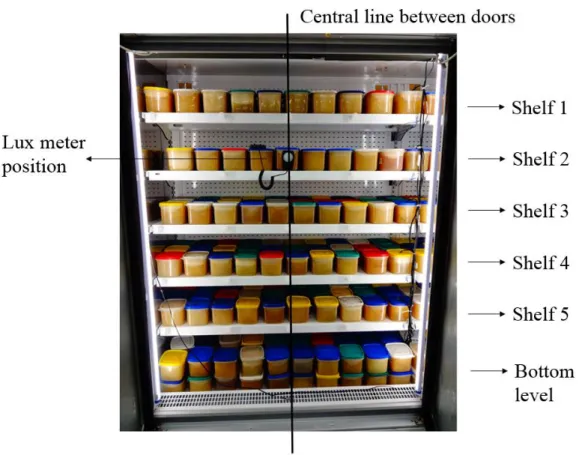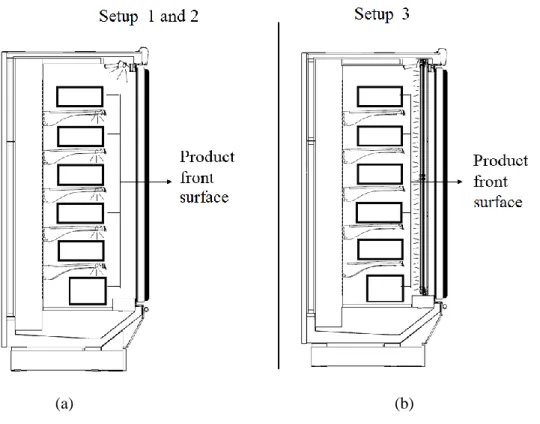IMPACT OF DIFFERENT LIGHTING CONFIGURATIONS IN ENERGY
CONSUMPTION OF GLASS DOORS MULTIDECK DISPLAY CASES
G. G. HEIDINGER
(a), S. M. NASCIMENTO
(b), P. D. GASPAR
(c), P. D. SILVA
(d)(a)(b) EletrofrioRefrigeração Ltda, r João Chede, 1599, Cidade Industrial,
Curitiba - PR, 81170-220, Brazil
+55 (41) 2105-6097, (a) gustavo@eletrofrio.com.br; (b) samuel@eletrofrio.com.br
(c) (d) University of Beira Interior, Engineering Faculty, Dept. of Electromechanical Engineering,
Covilhã, 6201-001, Portugal
+351 275 329 759, (c) dinis@ubi.pt; (d) dinho@ubi.pt
ABSTRACT
This paper reports the results of experimental tests performed in a glass doors multideck display case for medium temperature. This type of equipment considers a large reduction in the thermal load due the use of doors, however, a large part of the energy consumption is coming from the lighting. Experimental tests were performed with different types of lighting setup to measure the energy consumption and its consequent impact on the thermal load. The configurations tested were: fluorescent lamps and LED, both tested in horizontal (under the shelves) positioning and only LED were tested in vertical (next to the doors) positioning. Comparing with fluorescent lamps, experimental results show that LED illumination under the shelves reduces the direct energy consumption in 41% and the LED in vertical position results in 74% of energy economy. The illuminance depends on the position at which the measurement is made, LED illumination under the shelves results in a variation of -26 to +31% and LED in vertical position results in a
variation of -50 to +422%.The LED illumination in vertical positioning is the best alternative to save energy
and highlight the products exhibited.
1. INTRODUCTION
Knowing that 15% of the energy consumed in large supermarkets is attributed to the direct consumption of display refrigerators (ASHRAE, 2010), any study aiming to minimize this cost is of great value and importance. According to Gaspar et al. (2011), ASHRAE (2010) and Faramarzi (1999) the heat load due to ambient air entrainment in a vertical open refrigerated display case (ORDC) is 67% to 81% of total heat load. This condition occurs due to the large thermal entrainment promoted by the mixture of mass flows of the refrigerated air curtain and still air ambient. The use of an air curtain is required to ease customer access to the product he/she wish to purchase, increasing the sales potential (Nascimento et al., 2013) and simultaneously ensuring thermal separation between the refrigerated compartment and the hot and humid external environment. Frickie & Becker (2010) conducted a field study in which new beverage display cases were installed in two similar stores. In one store was installed a vertical open type while in the other was installed a vertical closed type. The increase of sales was respectively 29% and 27% while the power consumption of the open type was approximately 30% higher. Thus, while difference in the sales (2%) was no significant due to the presence of doors, the difference in power consumption was substantial. Therefore, there is no conclusion about the influence of doors, i.e. closing the display cases, in sales volume.
Concerning closed refrigerated display cases (CRDC), Orlandi et al. (2013) identified through numerical simulations that during periods when cabinets’ lighting is on, the heat generated by lamps is responsible for 25% of total thermal load. Lighting by fluorescent lamps is commonly used in both closed and open refrigerated display cases. Rea (2000) shows that losses in lighting performance can reach 25% when the ambient temperature drops from 25 °C to 7 °C, confirming the inefficiency of lamps used in refrigerated display cases. Raghvan and Narendran (2002) proposed lighting by LEDs in refrigerated display cabinets and proved the improvement in the quality of lighting the food products and the more attractiveness to the consumer due to clear visualization and vivid colours and therefore the consequent increase in sales number. Within this context, this paper presents the comparative results of three different lighting settings regarding the illumination and direct energy consumption in CRDC with glass doors. Based on the results, conclusions are provided to improve the thermal, energetic and sales performances of display cabinets.
2. EXPERIMENTAL PROCEDURE
Tests were conducted in an environmental test chamber. The ambient fluorescent lighting shall be installed to maintain 600±100 lx measured at a height of 1m above the floor level and shall be lit continuously during the test period (ISO 23953-2, 2005).
The refrigeration equipment selected for the experiments is a glass doors multideck display case (0,93m×2,62m×2,09m) shown in Figure 1 used for refrigerating and displaying dairy/deli products, which temperature should be maintained between -1 °C and 7 °C, product class M2 (ISO 23953-2, 2005).
(a) Experimental display case. (b) Display case front view.
Figure 1 – Glass doors multideck display case.
Three different lighting configurations were tested: (1) Horizontal fluorescent lighting above the doors and
under the shelves (N.er of lamps: 12; Power: 32W; Length: 1200mm; Type: T8; Light temperature: 4000K);
(2) Horizontal Light-Emitting Diode (LED) lighting above the doors and under the shelves (N.er of
lamps: 12; Power: 19W: Length: 1200mm; Light temperature: 4000K) and (3) Vertical LED lighting near
doors’ frame (N.er of lamps: 4; Power: 25W; Length: 1500mm; Light temperature: 4000K). The three
configurations are shown in Figure 2.
(a) Setup 1 and 2: Lat. view. (b) Setup 3: Lateral view. (c) Setup 3: Front view.
Figure 2 – Different tests setup.
Measurements of illuminance, i.e. the total luminous flux incident on a surface per unit area, were performed where the vertical lighting is most deficient, i.e., between two LED lamps on the front surface of products displayed in each shelf (see Figure 3), since that is the front surface of products that should be illuminated to draw consumers' attention.
Figure 3 – Measurement points and positions (doors opened).
When the illuminance measurements were performed, only the lamps of the display case were turned on. All other light sources in the test chamber were turned off. The data acquisition of illuminance was made with a lux meter and the electrical power of the lamps was acquired with a digital transducer.
3. ANALYSIS AND DISCUSSION OF RESULTS
The values of the illuminance measurements at different heights and the average value on the three setups are shown in Table 1. This table also includes the percentual difference of illuminance between configurations.
Table 1 – Illuminance values for different setups.
Position Illuminance [lx] Difference [%]
1 2 3 2 / 1 3 / 1 3 / 2 Shelf 1 740 834 370 13 -50 -56 Shelf 2 216 282 461 31 113 63 Shelf 3 115 149 523 30 355 251 Shelf 4 101 107 527 6 422 393 Shelf 5 118 103 480 -13 307 366 Bottom level 156 115 311 -26 99 170 Average 241 265 445 7 208 198
In configurations 1 and 2 the level of illuminance on the first shelf is too high due to lamp located above the doors. The illuminance values in the other shelves is impaired due to the lamp position that lights the top of
the product and not its front surface that needs to be highlighted (Figure 4a). This problem is emphasised when the refrigerated display case is stocked with full load. In the configuration 3 there is a reduction of the first-shelf lighting due to the absence of a lamp above the doors, but the front surface of products is better illuminated in the other shelves (Figure 4b).
(a) (b)
Figure 4 – Incidence of the luminous flow.
Comparing configurations 1 and 2, it can be verified a higher illuminance level with LED demonstrating the low efficiency of fluorescent lamps in cold environments. The light above the door has a higher luminance with LED, however, the lights under the shelves appear to have a lower luminance. This is particularly obvious at the bottom level. The configuration 2 features illuminance values ranging from -26% to +31% depending on the measurement position. In certain positions, the LED luminous flux does not reach satisfactory the products due to higher flow direction having an aperture of 120° in relation to the 360° of the fluorescent lamp which, in turn, consumes more energy to illuminate in all directions.
In configuration 3 and analysing Figure 3, the results obtained by Raghvan & Narendran (2002) showing that lighting is more uniform with LED system compared to the fluorescent system are confirmed. There is a non-uniform distribution of the luminous flux in the centre (between the doors) and at edges that are more illuminated, but even so the illuminance is superior in almost every position. Also is noteworthy that configuration 3 shows the most satisfactory illuminance result with only 4 lamps with 1500mm in relation to 12 lamps with 1200mm of configurations 1 and 2. Thus, it is verified that horizontal lighting is less effective than vertical lighting.
The electrical power of configuration 2 is 41% lower than configuration 1 and the electrical power of configuration 3 is 74% lower than to configuration 1.
4. CONCLUSIONS
A large part of the energy consumption in closed refrigerated display cases is from electrical consumption of lighting and it heat load. Experimental tests were performed in a glass doors multideck display case for medium temperature with different types of lighting setup to measure the energy consumption and its consequent impact on the thermal load. The configurations tested were: fluorescent lamps (configuration 1)
and LED (configuration 2), both tested in horizontal (under the shelves) positioning and LED in vertical (next to the doors) positioning (configuration 3). The effect of the lighting on product temperatures was not considered in this study.
Among the three configurations testes, the best lighting option for closed refrigerated display cases with glass doors is the vertical lighting with LED (configuration 3). This configuration provides the highest illuminance level on the front surface of products and also the lower power consumption.
LEDs still require a high initial investment compared to fluorescent lamps. However, the LED technology (lumen output, efficacy, thermal properties, substrate materials, light distribution pattern, LED capacity and forward voltages) has been evolving rapidly over the years. By other hand, the improvements in manufacturing technology are driving the prices down to a level where LED lamps are becoming cost-effective. When is taken into account the useful lifespan, maintenance costs and the installation complexity and time of 12 fluorescent lamps with ballasts in relation to quicker and simpler installation of 4 LED lamps, in this specific application the LED configuration becomes economically viable.
REFERENCES
[1] ASHRAE 2010, ASHRAE Handbook: Refrigeration, American Society of Heating, Refrigerating and Air-Conditioning Engineers, Inc.
[2] Gaspar, P., Gonçalves, L., Pitarma, R. 2011, Experimental analysis of the thermal entrainment factor of air curtains in vertical open display cabinets for different ambient air entrainment factor of air curtains in vertical open display cabinets for different ambient air conditions, Applied Thermal Engineering 31(5): 961-969
[3] Faramarzi, R. 1999, Efficient display case refrigeration, ASHRAE Journal 41(11): 46-52.
[4] Nascimento, S., Heidinger, G., Gaspar, P., Silva, P. 2013, Isolamento térmico por cortinas de ar em expositores refrigerados – Comparação do desempenho térmico em ensaio laboratorial, loja aberta e loja fechada, International Conference on Engineering, Covilhã, Portugal. (in Portuguese)
[5] Frickie, B., Becker, B. 2010, Doored display cases, ASHRAE Journal 52(9): 18-26.
[6] Orlandi, M., Visconti, F., Zampini, S. 2013, CFD assisted design of closed display cabinets, 2nd IIR
International Sustainability and the Cold Chain Conference. [7] Dr. Rea, M. 2000, IESNA Lightning Handbook.
[8] Raghavan, R., Narendran, N. 2002, Refrigerated display case lighting with LEDs, Solid State Lighting II: Proceedings of SPIE.
[9] ISO 23953-2 2005, "Refrigerated display cabinets - Part 2: Classification, requirements and test conditions", International Organization for Standardization.


